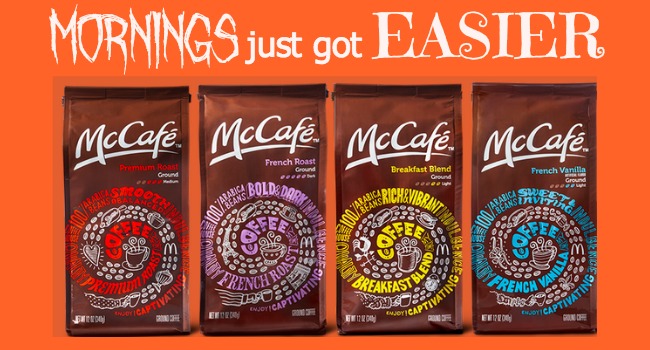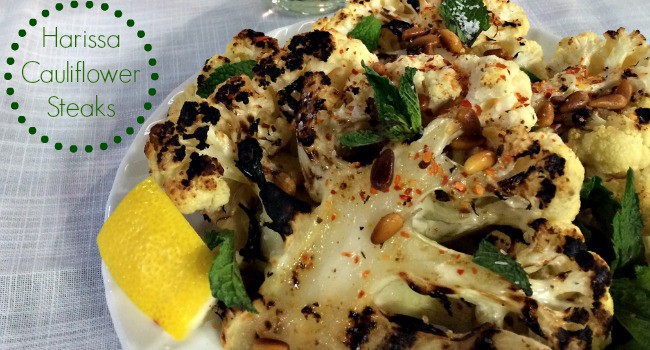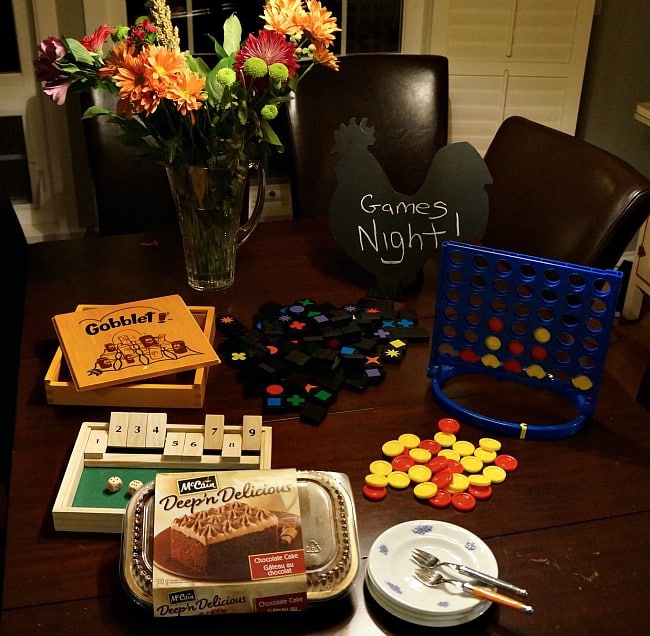“Here comes Peter Cottontail….hoppin down the bunny trail…” The popular Easter song echoes through my mind as I walk through my local grocery store, observing the pastel coloured chocolates, the brightly packaged plastic eggs, and the plethora of bunny-themed paraphernalia littering the aisles. It can only mean one thing: Easter is on its way.
When you are serving vegetarian or want a tasty, light and healthy dinner, our harissa cauliflower steaks are always a huge hit!
A family games night always thrills my kids, and after a busy start to the school year, I decided to surprise the boys with just that.
We’ve all been there: unloading the backpack at the end of the day and throwing away half-eaten sandwiches and mushy bananas.
 There’s a joke in my house about me not being a morning person. But it goes further than that. I’m so groggy in the morning that I probably should have padded walls in the hall and a bathrobe made of bubble wrap so that I don’t hurt myself on the way to the coffee maker. Unless I make it the night before I always measure wrong. One friend laughed and told me it was ‘simply’ the miles to kilometers ratio for portioning coffee to water. That didn’t help much.. If I had a few million dollars I wouldn’t hire a cleaning lady or a chef. I’d hire somebody to place my coffee beside the bed in the morning so that I could wake to the scent and avoid EMI – early morning injury.
There’s a joke in my house about me not being a morning person. But it goes further than that. I’m so groggy in the morning that I probably should have padded walls in the hall and a bathrobe made of bubble wrap so that I don’t hurt myself on the way to the coffee maker. Unless I make it the night before I always measure wrong. One friend laughed and told me it was ‘simply’ the miles to kilometers ratio for portioning coffee to water. That didn’t help much.. If I had a few million dollars I wouldn’t hire a cleaning lady or a chef. I’d hire somebody to place my coffee beside the bed in the morning so that I could wake to the scent and avoid EMI – early morning injury.
 When McCafé first launched I had the opportunity as an all-access-mom to work behind the counter at a McDonald’s restaurant where I could act professional and run the barista machine. Incredible. Perfect every time (it was the machine), full of flavor and float-on-a-cloud aromas. I got slightly addicted. But then I ran into the issue of having to jump in my car in the morning in a half-awake state in order to reach the drive-thru for coffee. Not a wise move. The last time I tried I drove over my purse whilst backing up. I remember at university McDonald’s used to deliver to our residence. MMMM. Can you imagine fresh-brewed McCafé in the morning delivered all steamy and rich after you’ve been up all night writing a paper?
When McCafé first launched I had the opportunity as an all-access-mom to work behind the counter at a McDonald’s restaurant where I could act professional and run the barista machine. Incredible. Perfect every time (it was the machine), full of flavor and float-on-a-cloud aromas. I got slightly addicted. But then I ran into the issue of having to jump in my car in the morning in a half-awake state in order to reach the drive-thru for coffee. Not a wise move. The last time I tried I drove over my purse whilst backing up. I remember at university McDonald’s used to deliver to our residence. MMMM. Can you imagine fresh-brewed McCafé in the morning delivered all steamy and rich after you’ve been up all night writing a paper?
Though I still do a fair amount of last-minute writing, pigs can’t fly and I’m no longer in a university residence, but a thrilling coffee solution has fallen into my kitchen. McCafé is now sold in every major grocery retailer in Canada. To keep in your pantry! McCafé at HOME! In Canada, 65% of coffee is consumed in the home. I suspect that stat is about to go up… And if you have a fancy coffee maker you’re still golden – it comes in K-Cup, Tassimo T-Discs, or Ground. BOOM.
Now if McDonald’s could just teach my kids the miles to kilometers ratio…
Going to camp is an exciting summer activity for kids. Meeting new people, learning new games and going on adventures are some camp memories that are never forgotten. We have compiled a list of camp must-haves that will make your kids experience at camp even better…
1. Pop Clocky. As most of us know, being at camp doesn’t mean sleeping in. Early wake up calls are inevitable. With Pop Clocky you can wake up the whole cabin with a fun start to the day. Pop Clocky resembles a Jack-in-a-box and makes early mornings fun. Sunny, Rosy, Gilbert and Charlie will make sure everyone up with the birds.
2. Allergy alerts from Mabel’s Labels will ensure that the peanut butter doesn’t pass the lips when the kids come back from canoeing a wee bit dazed and sunburned.
3. A few healthy snacks. Hippie Foods coconut snacks arrived at our office and I’m now hoarding them in my desk…. .
4. A Flashlight. For those long walks back to the cabin, in the woods, a flashlight is useful for avoiding injuries. We found one that’s also a portable music player – the Hipstreet bluetooth speaker/radio with flashlight will keep them dancing around the campfire!
5. A Journal. You can’t experience your child’s week at camp with them, so, by getting them to keep a journal they can keep up their writing skills and share every bit of their experience with you when they get home. We love this robot illustrated Mudpuppy journal/sketchbook.
6. A water bottle. Though you won’t be there to tell them to drink water and stay hydrated every minute, getting them to bring a water bottle will encourage them to drink more water and I’m sure they will be thanking you later. Having one of these adorable SIGG animals will make them want to keep it close.
7. An Eco Lunchbox. For those days when they’ll be going on an adventure and will be needing to carry around some snacks with them.
8. A backpack. A a similar idea to the eco lunchbox, when your kid is going on an adventure they will have a lot to carry. Whether it be sunscreen, a water bottle or a flashlight, your kid will be glad to have a backpack to put it all in. Companies like Land’s End allow for easy personalization.
9. Their own pillow case. She won’t have a chance to miss home when dozing off on this festive Mum pillowcase from Pottery Barn Kids. Better yet – you’ll avoid having a child return home with lice. It will be a reminder of home and be a lice blocker at the same time!
Switching to organic is a tough decision for many families. By choosing organic versions of the family’s most consumed foods, you can increase the percentage of organic food in your diet without big changes to your shopping cart or your spending. Opting for organic produce, for instance, doesn’t necessarily have a big impact, depending on what you eat. The key is to be strategic in your organic purchases. But how do you switch to organic? Like this.
According to the Environmental Working Group, commercially-farmed fruits and vegetables vary in their levels of pesticide residue. Here’s their standard of when to choose organic and when it’s OK to go conventional.
Dirty Dozen—These should always be organic: Nectarines, Celery, Pears, Apples, Cherries, Berries, Imported Grapes, Spinach, Potatoes, Bell Peppers, Lettuce.
Clean fifteen—It’s OK to opt for conventional here: Onions, Avocados, Sweet corn, Pineapple, Mangos, Asparagus, Sweet peas, Kiwi, Cabbage, Eggplant, Papaya, Watermelon, Broccoli, Tomato, Sweet potato. (Tip: Print this and slip it in your wallet.)
Why Organic?
Nutrient Dense: Reports of organic food not being better for you are outdated. A brand new analysis of about 100 studies, including more than 40 published in the past 3 years, found that the average levels of nearly a dozen nutrients are 25% higher in organic produce.
Consume Fewer Toxins: Eating the 12 most contaminated fruits and vegetables exposes you to about 14 pesticides a day. A study supported by the EPA measured pesticide levels in children’s urine before and after a switch to an organic diet. After just 5 days, the chemicals decreased to trace levels.
TOP ORGANIC PICKS
1. Milk: Most children drink milk everyday or in large quantities so this is one product not to skimp out on when it comes to choosing between organic and non. Also, when you choose a glass of conventional milk, you are buying into a whole chemical system of agriculture. Organic milk doesn’t contain the harmful antibiotics, artificial and growth hormones and pesticides that are used in commercial dairy.
2. Potatoes: Potatoes are a staple of the North American diet—an alarming fact in itself—one survey found they account for 30% of our overall vegetable consumption. A simple switch to organic potatoes has the potential to have a big impact because commercially-farmed potatoes are some of the most pesticide-contaminated vegetables. Root vegetables absorb herbicides, pesticides, and fungicides that wind up in soil. Potatoes are treated with fungicides during the growing season, and then sprayed with herbicides to kill off the fibrous vines before harvesting. After they’re dug up, the potatoes are treated yet again to prevent them from sprouting. Try this experiment: Buy a conventional potato in a store, and try to get it to sprout. It won’t. 81% of potatoes tested still contained pesticides after being washed and peeled, and the potato has one of the highest pesticide contents of 43 fruits and vegetables tested, according to the Environmental Working Group.
3. Peanut butter: More acres are devoted to growing peanuts than any other fruit, vegetable or nut, according to the U.S.D.A. More than 99% of peanut farms use conventional farming practices, including the use of fungicide to treat mold, a common problem in peanut crops. Given that some kids eat peanut butter often, this seems like a simple and practical switch. Commercial food firms now offer organic brands in the regular grocery store. Even opt for grinding your own in store. Kids love the process watching the nut transform into paste!
4. Ketchup: For some families, ketchup accounts for a large part of the household vegetable intake—another sad fact in itself. About 75 percent of tomato consumption is in the form of processed tomatoes, including juice, tomato paste and ketchup. Notably, recent research has shown organic ketchup has about double the antioxidants of conventional ketchup.
5. Apples: Apples are the second most commonly eaten fresh fruit, after bananas. But apples are also one of the most pesticide-contaminated fruits. Why? They are individually grafted (descended from a single tree) so that each variety maintains its distinctive flavor. So apples don’t develop resistance to pests and are sprayed frequently. The industry maintains that these residues are not harmful. Don’t buy that. So minimize exposure by avoiding the most pestiside doused produce but choosing organic apples. The good news is that organic apples are easy to find.
6. Popcorn: Chemicals, like perfluorooctanoic acid (PFOA), in the lining of the microwave popcorn bags, are part of a class of compounds that may be linked to infertility in humans. Studies show that microwaving causes the chemicals to migrate into your popcorn and accumulate in the body for years. Many manufacturers will phase out PFOA by 2015 under a voluntary EPA plan, but millions of bags of popcorn will be sold between now and then. The solution: Pop organic kernels the old-fashioned way—in a skillet. For flavorings, add real butter, olive oil, or dried seasonings, such as dill, vegetable flakes or nutritional yeast. Bonus is that air-popped popcorn is a whole food, high in nutrients and a way cheaper snack food option.
7. Canned Tomatoes: The resin linings of tin cans contain bisphenol-A, a synthetic estrogen that has been linked to ailments ranging from reproductive problems to heart disease, diabetes and obesity. Unfortunately, acidity—a prominent characteristic of tomatoes—causes BPA to leach into your food. Choose tomatoes in glass bottles (which do not need resin linings). Substitute low sodium organic jarred pasta sauce for canned tomatoes when a recipe calls for canned tomatoes and none are on hand.
8. Meat and Poultry: A study in the journal Meat Science compared the nutritional content of organic and nonorganic chicken meat. The researchers found that the organic samples contained 28% more omega-3s which are linked to reducing rates of heart disease, depression, type 2 diabetes, high blood pressure, inflammation and Alzheimer’s disease. Animals raised organically are not given antibiotics, growth hormones or feed made from animal by-products (read: they don’t eat their own species).
Money Saving Tricks When Buying Organic
In-Season Savings: Hunt for produce at your local farmer’s markets. Buy organic produce in season (preferably local), when it’s most affordable—usually at half the cost. Not only does your wallet benefit, but also do the local farmers. Produce is farm fresh with a much zingier taste as it was probably just picked that day. Plus, little energy was wasted in its journey from the farm to kitchen.
Buy in Bulk: Organic options can be found at Costco—like organic bagged brown rice, whole-wheat flour and quinoa. Stock up on these, They don’t go bad and you will use them more often when on hand. You can also find many organic grains—brown rice, whole oats, pastas, flours, dried fruits, and nuts in bulk sections of stores for far less.
Portion Control: The recommended portion size for meat and poultry is three ounces, the size of a deck of cards. Stick to this amount and round out your meal with less expensive whole grains and veggies not only to cut meal costs, but also to drastically improve nutritional intake.
Organics to Skip: Which products don’t require the hefty price tag? Step into any health food store and you’ll find an organic version of just about everything, including junk food. While it’s true that organic is still better for you, soda is still soda, even with an organic label. A six-pack of organic soda contains 160 calories and zero nutrients. So skip it entirely. Cutting back on sweets and nutritionally void extras altogether is the best step to better health and won’t sabotage your shopping budget that should be spent on healthy whole foods.
– Alyssa-Schottland Bauman received her training to practice Health Counseling at the Institute for Integrative Nutrition, which is the only nutrition school integrating all the different dietary theories—combining the knowledge of traditional philosophies with modern concepts like the USDA food pyramid, the glycemic index, the Zone and raw foods. www.nourished.ca
Photo: http://www.flickr.com/photos/jdickert/
In my house we call it go-geet. We also call muffins cupcakes. Do you see a pattern? (besides teaching the kids horrific spelling?) Yes, I try to convince the kids that the healthy desserts are actually sinful. We recently sampled the new iögo 0% yogurt with stevia extract, a100% natural origin calorie-free sweetener. They loved it. They took it for school lunches, ate it after dinner and I popped it into smoothies.
Thankfully, according to the FDA and Health Canada, you can’t overdose on stevia extract. Stevia extract is a 100% natural origin calorie-free sweetener made from the leaves of the stevia plant. It’s manufacturing process is the same as for natural flavours. Known first as the “sweet herb”, stevia is a native plant of Paraguay, South America and is 200 to 300 times sweeter than white sugar. When used in very small quantities, stevia extract can replace a portion of the sugar generally used in food products. As of November 2012, Health Canada approved the use of stevia extract in Canada. This agency established the safety of stevia extract as a food additive.
iögo 0% with stevia extract is free of fat, gelatin, colours and artificial flavours. It comes in the flavours of raspberry, blueberry, vanilla and mango-passion fruit. So have your cupcakes with go-geet. We won’t tell.
The garden is thriving and the kids have been eating poorly since school got out. Well, mine have anyway. Time to hide some veggies in their favourite foods. When we made these summer zucchini muffins, we tripled the recipe, baked one pan of muffins and saved the other two batches in large ziplock bags in the freezer. A perfect start to the school year. Simply defrost the dough the night before and fill 12 tins for fresh breakfast treats or lunchbox snacks.
3 cups grated fresh zucchini (no need to take the peel off. The green adds depth.. and saves you time.)
2/3 cup melted unsalted butter
1 cup brown sugar
2 eggs, beaten
2 teaspoons vanilla
2 teaspoons baking soda
Pinch salt
3 cups all-purpose whole wheat flour (or replace 1 cup with wheat germ)
2 teaspoons cinnamon
1/2 teaspoon nutmeg
1 cup walnuts (optional)
1 cup raisins or dried cranberries (optional)
You don’t need a mixer for this recipe.
1. Preheat the oven to 350°F (175°C). In a large bowl combine the sugar, eggs, and vanilla. Stir in the grated zucchini and then the melted butter. In a separate bowl, mix together the flour, baking soda, nutmeg, and cinnamon. Stir these dry ingredients into the zucchini mixture. Stir in walnuts, raisins or cranberries if using.
2. Coat each muffin cup in your muffin pan with a little butter or vegetable oil spray. Use a spoon to distribute the muffin dough equally among the cups, filling the cups up completely. Bake on the middle rack until muffins are golden brown, and the top of the muffins bounce back when you press on them, about 25 to 30 minutes. Set on wire rack to cool for 5 minutes. Remove muffins from the tin let cool another 20 minutes.
If you’re used to picky eaters or chicken finger lovers, kid friendly crab cakes make a great healthy snack. And it’s not necessary to catch the crabs and shell them like we did (for authenticity). You can grab the cans. You also have the option of frying or baking. The baked version is of course healthier, but you could do a flash fry at the end using olive or grapeseed oil (which has a higher temperature threshold to prevent burning). Served with veggies or a robust salad they make a great dinner as well.
Kid Friendly Crab Cakes Ingredients:
4 T. finely crushed whole grains (kamut, wheatgerm, wholewheat flour – whatever you have)
2 tablespoons mayonnaise
1/2 teaspoon Dijon mustard
1/2 teaspoon seafood seasoning/cocktail sauce
1/4 teaspoon Worcestershire sauce
1 egg, beaten
salt to taste
1 pinch cayenne pepper (optional)
1 pound fresh crabmeat, well drained
1/4 cup dry bread crumbs (try to use whole grains seasoned with just salt and pepper)
2 tablespoons butter
3T cut chives
6 T finely diced apple (optional)
Method:
- Mix grains, mayonnaise, Dijon mustard, seafood seasoning, Worcestershire sauce, egg, salt, and cayenne pepper in a large bowl.
- Stir in crabmeat until mixture is combined but still chunky. Cover and refrigerate for 1 hour.
- Sprinkle breadcrumbs on a plate.
- Shape chilled crab mixture into 4 small thick patties; coat completely with bread crumbs.
- Grease a cookie sheet and place in the oven at 350 degrees for 20 minutes. Flip crabcakes at 10 minutes.
- Optional: flash fry for 30 seconds/side in a skillet before serving.
This kid friendly crab cakes recipe is also great for making shapes – the letters in the kids’ names, hearts, stars and geometric shapes. Have fun!





